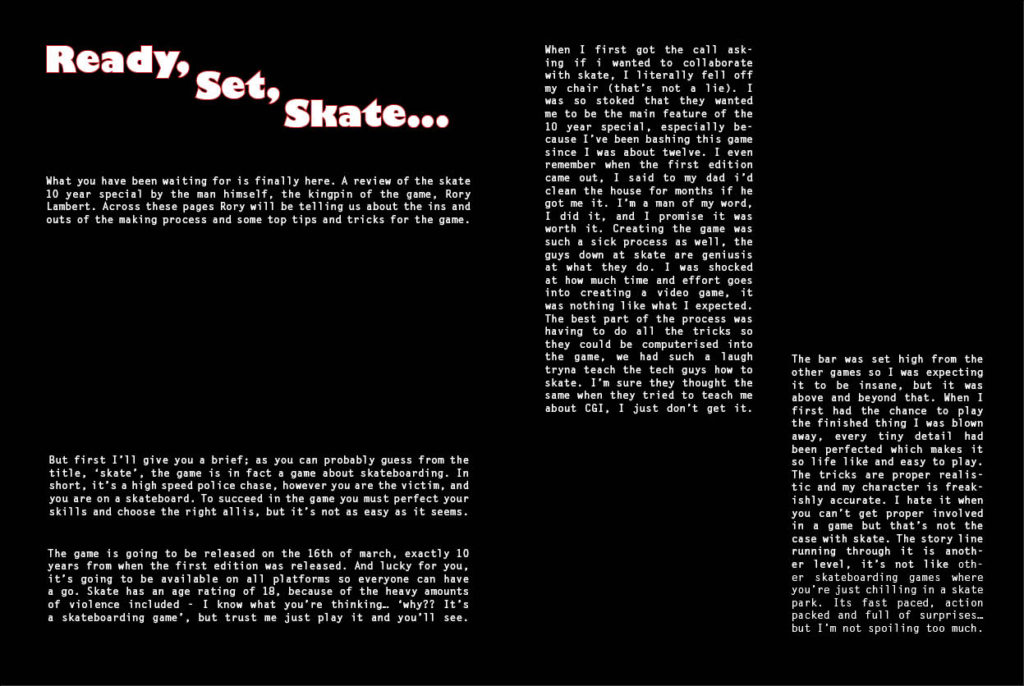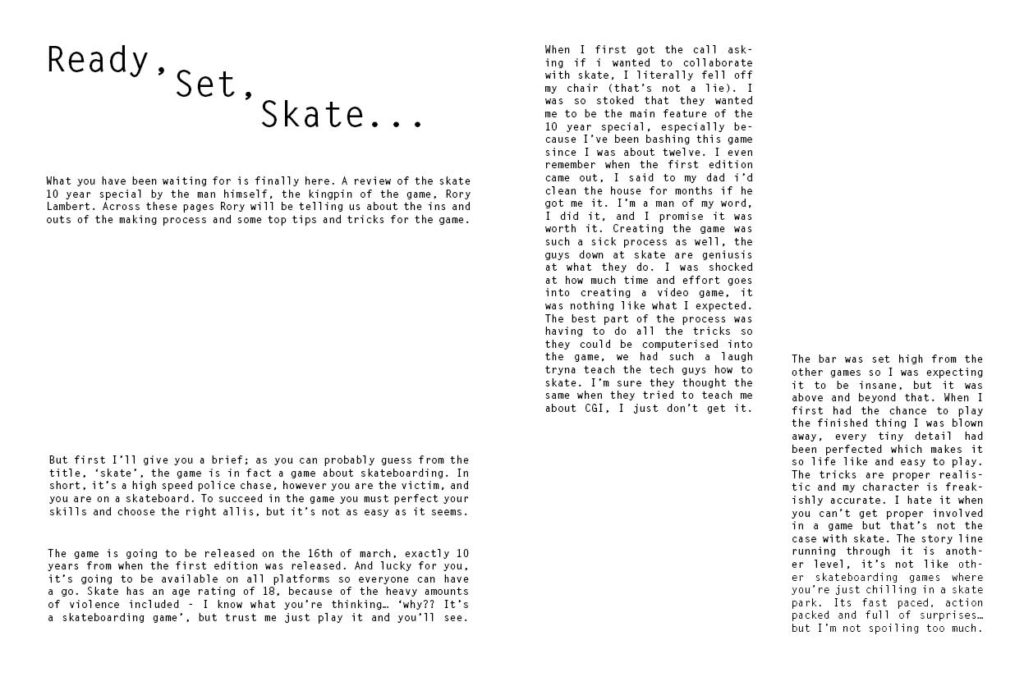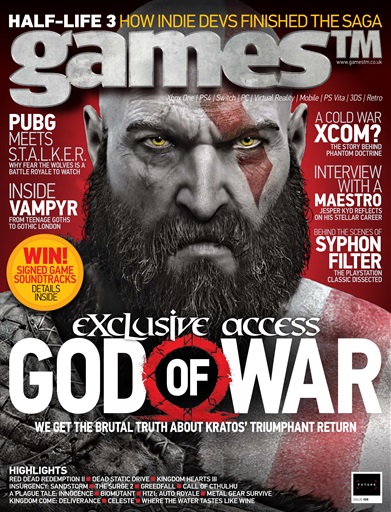Monthly Archives: January 2020
Filters
contents page
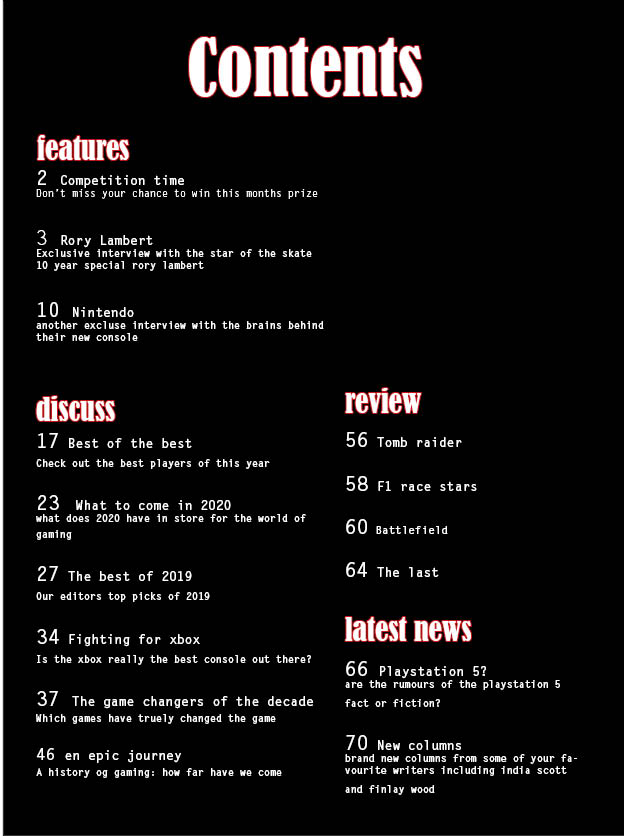
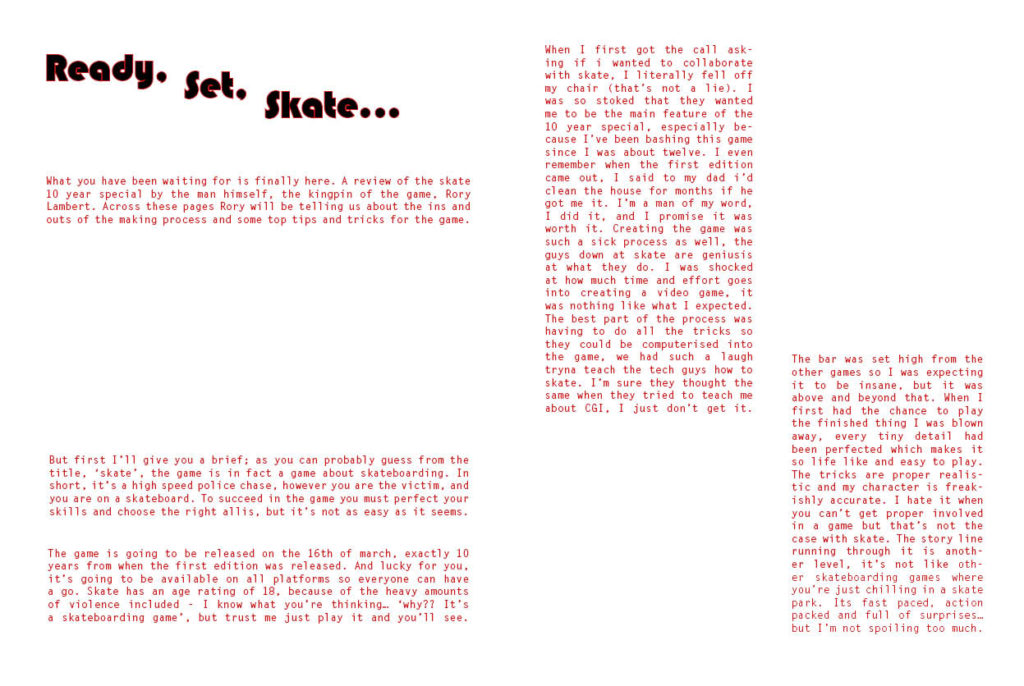
NEA draft
just need to add photos
Front Cover & Contents
NEA Coursework
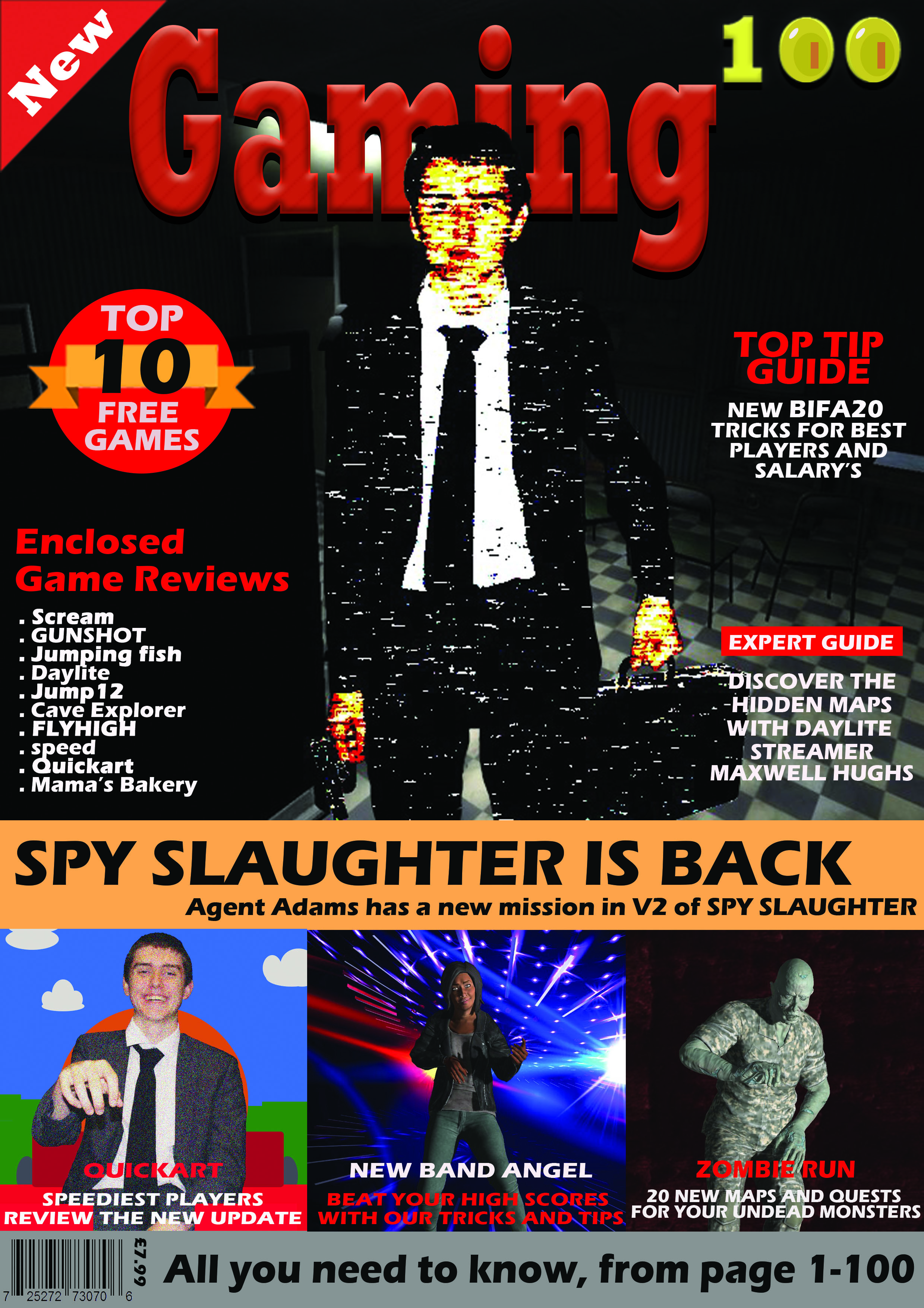


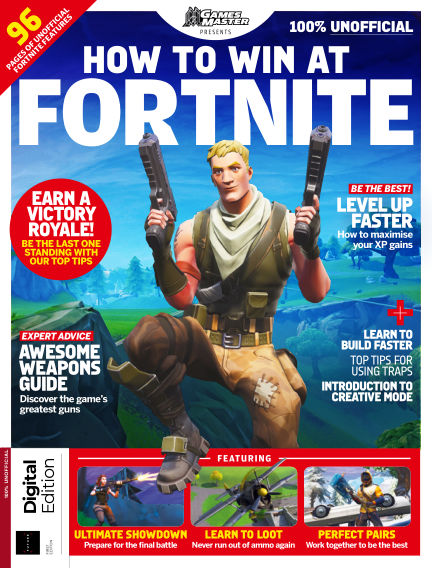


Statement of Intent
The target audience for my gaming magazines is aimed at teenagers, predominantly between age 12 and 16, interested in a range of different games. I chose the title ‘Gaming 100’ representing the 100 pages of my magazine, which allows this magazine to be inclusive to both boys and girls, with any genre of gaming interest.
My aim was to have a magazine that has something for all teenage gamer’s, and with that I chose an overall basic colour theme with black, white and red, but also included a musty yellow to add a brighter colour. I designed the ‘100’ of my masthead to have the two zeros as coins, similar to ones collected in various video games, to keep the design closely and clearly linked to gaming, and therefore recognizable to the reader. A sans-serif font was used to create an informal and relaxed look, suitable for a teen based magazine. I based the layout on a fortnite magazine cover I had in class, using the rule of thirds to help guide the reader around the cover, with a main image on the whole top half, but with the masthead slightly covered by the dominant signifier. Then on the bottom third, a gallery of 3 more images and captions to display some of the articles inside. I used extra puffs and plugs on the sides to include as much information about the pages found inside, to interest as many possible consumers.
With the contents page and double page spread I referred closely to my style models, and kept the colour theme running through, with a bold and basic font often found in gaming magazines. I included lots of original imagery and created a game for a step by step guide which was found in many pages of my style model.
I gave the magazine a reasonable price for a 100 page magazine, to be affordable and accessible to the younger teenage audience, who would mostly be middle class student, possibly with only a small pocket money allowance.
NEA Coursework
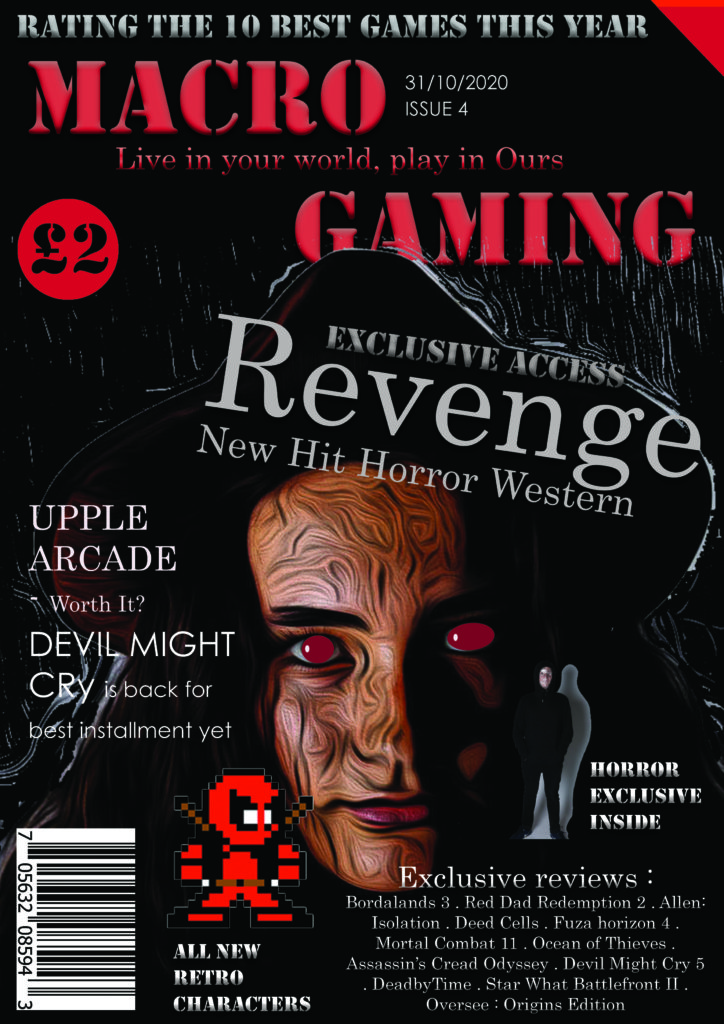


STYLE MODELS

STATEMENT OF INTENT
My working title is Macro Gamer to emphasis the scale and variety of content in my magazine. My target audience is both men and women however primarily women, aged between 16 to 25. This is because my magazine is filled with strong women as the main protagonists and antagonists. Being more mature, my colour pallet is mainly black, white and red. This is more of a horror gaming magazine as there are dark images which is more R rated then generic magazines however does apply a more child-like nature with the 8 bit art. The audience conforms to the emergent service workers due to being very young but high levels of cultural capital. Also, my target audience are part of the Explorers in Rubicam’s 4 C’s due to many games being covered in my magazine being a challenge or adventurous. My magazine will cover reviews, exclusive interviews and a couple new emerging games and my cover is easy for people who are not fully cultured in the game industry due to using more informal language but also rewarding for those who are. I believe my magazine challenges the dominant ideology as it has strong female characters that aren’t over sexualised, such as my dominant signifier on my front cover and double page.
teenvogue
Teen Vogue is a former US print magazine and current online publication launched in 2003 as a sister publication to Vogue, targeted at teenage girls. Like Vogue, it included stories about fashion and celebrities. The magazine had also expanded its focus from fashion and beauty to include politics and current affairs.
Condé Montrose Nast, a New York City-born publisher, launched his magazine empire in 1909 with the purchase of Vogue, which was first created in 1892 as a New York weekly journal of society and fashion news. At first, Nast published the magazine under Vogue Company and did not incorporate Condé Nast until 1923.
een Vogue was established in 2003 as a spinoff of Vogue and led by former Vogue beauty director Amy Astley under the guidance of Anna Wintour with Gina Sanders as founding publisher. The magazine is published in a smaller 6¾”x9″ format to afford it more visibility on shelves and some flexibility getting into a digest size slot at checkout stands. Teen Vogue‘s original price was $1.50 (USD)–“about as much as a Chap Stick” media critic David Carr noted–and about half the price of contemporaneous magazines aimed at a similar demographic, like Seventeen and YM. At launch, founding editor-in-chief Astley said that topically, Teen Vogue would focus on doing “what we do well, which is fashion, beauty and style.”Teen Vogue was the first teen-focused addition to the Condé Nast portfolio, previously focused on adult audiences. The publication began with four test issues, then published six issues in 2003 and ten in 2004.
content
fashion
sexuality
politics
teenvogues worth
Halsey was meant to make albums, and it shows
From start to finish, from lyrics to production, Halsey’s third album “Manic” tells a complex story.
BY AAMINA KHAN
https://www.teenvogue.com/story/halsey-new-album-manic-a-track-by-track-review
Halsey’s New Album “Manic”: A Track-by-Track Review
.jpg)
NEA coursework front cover contents page

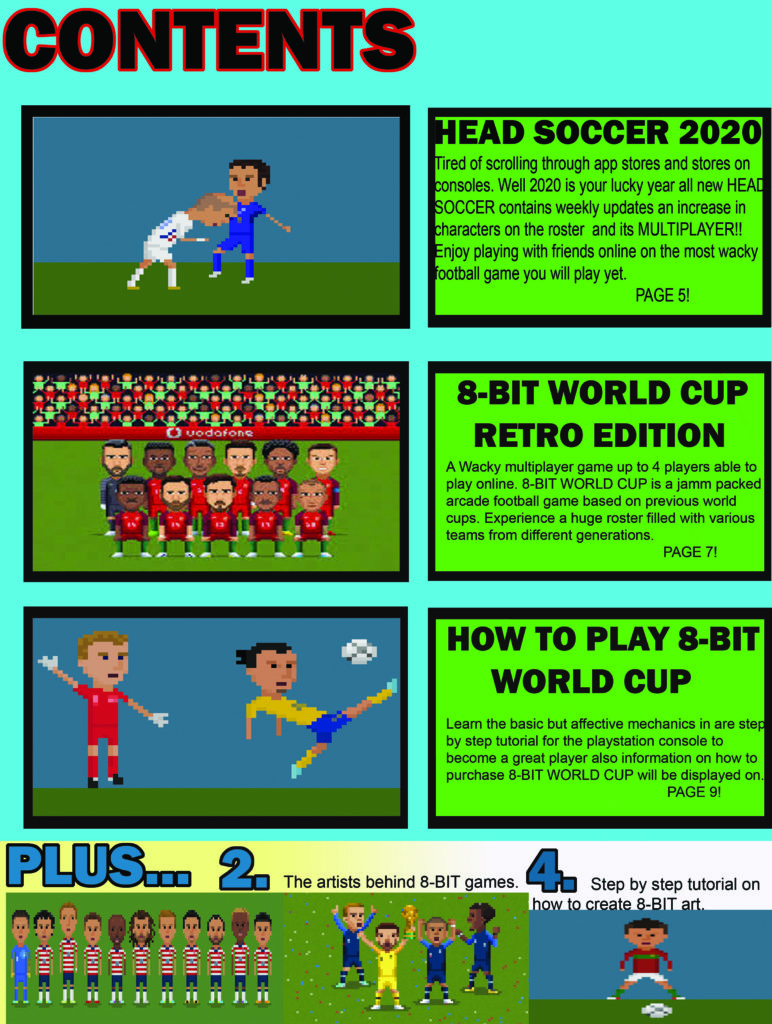
Statement of intent
The target audience for my magazine is targeted at 13-15 years old’s who have a strong interest in gaming. They would also be in education and wouldn’t work but the parents would be middle class. The point of my magazine is to provide escapism and enjoyment for its readers, the goal is for them to want read and learn more about here favorite games.
I researched into what gaming covers look like, what games are enjoyed and the most popular types. I used a gaming cover to base my cover from by being inspired by there layout and how they had presented it to give it an overall fun look.
I decided to do my magazine on reviewing the most popular gaming icons and rating them, this would be done by a made up YouTube star. This would be a reactionary sign due to it being very common for male video gamers to bring out magazines. I used many popular gaming icons which I made on 8 bit art which captures an. audience due to there popularity. I used a black background to make the characters stand out against the dark background. I used a plugs to show the context and to make it more appealing.
Overall i think i did a good job at creating a interesting magazine cover which attracts attention and serves the purpose of providing people with the choice to escape reality.
Representation My magazine cover follows dominate ideology (reactionary) because the reviewer of the games is a male which is common for gaming magazines. My front cover is also mainly about popular game characters which is again common game idea and often used, this makes it an iconic sign as it is so recognizable.
Audience theory My audience would interpret my magazine as dominant reading as there interested in gaming, other people may view it as oppositional or negotiated but the people how buy it will enjoy gaming so they will like it.

